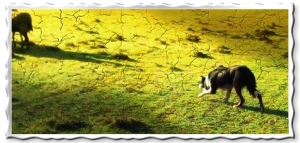Habit?
No not like the nuns wear — although those are black and white :@)
Most of my students seem to understand the concept that every dog is different but most don’t seem to correlate (even after acknowledging the differences in their dogs) they need to learn to incorporate solutions that include the dog, the problem, the handler, the sheep and the response given to all the above.
So, just what does that mean for you and your dog? Simply … you need to acquire the ability to “stand back” and REALLY see/hear what you are doing and how your dog is responding. If you and your dogs problem keeps recurring … then maybe you have created a habit that needs to be broken.
I’ve read that out of an estimated 11,000 signals we receive from our senses, our brain only consciously processes 40. The rest are accomplished without actually thinking about it or in “other words” … a lot of actions have developed into a habit. A habit is any action that we have performed so often that it becomes almost an involuntary response. So, if you having “issues” you need to learn to be aware of your actions – so it ceases to be an involuntary act. This will allow you to make a choice instead of just responding every time you perform this action.
Example: at “one point” in my training I was having an issue with dogs not stopping with my down whistle so I started to pay attention to the interaction between myself, my dog and my whistling. The conclusion: I was whistling … dog wasn’t responding … so I verbally said lie down. Thereby teaching my dog the whistle was a warning … but not a command. It was a habit I had adopted from training young dogs before they knew what a whistle was. However, after I had the habit it wasn’t long before all my dogs had acquired MY bad habit. They waited until they heard “the word” and weren’t responding to the whistle. So, I stopped using the verbal and started walking out to correct them with just the whistle. It had become such a habit I wasn’t even aware of it until I made myself … take a step back and observe myself objectively.
If you are having “issues” try to find out if it’s something that has become a habit. I’ve seen students say “lie down” (same tone) 3 times and then (and only then) start walking toward the dog YELLING “lie down” and for some “unknown” reason only “then” the dog downs. The dog understands he really doesn’t have to lie down until they yell … then they wonder why the training session always ends in yelling.
You need to stop, step back and pay attention to you and your dogs interactions. This is what lessons/clinics are good for – someone that’s not emotionally involved can help you figure out the WHY … this hopefully will allow you to get to a solution. Why the dog is reacting as he is … is first on the agenda and once that is solved — then you can work on finding the “ammunition” you need to fix the problem. ![]()
